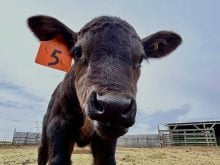Patti Anhorn grew up on a grain farm in the Elrose, Saskatchewan area, and while she loved that, it quickly became apparent her family’s farm was missing something.
Namely, cattle and horses. She jokes her parents would ship her over to a nearby farm that had livestock and horses so she could get her fill.
Little did she know that years later, everything would come full circle and she would raise cattle on that land with her husband, Gerald. He grew up on a mixed farm operation in the Maple Creek area.
Read Also

Harvest wraps up and fall work begins
At the Eppich famly ranch in western Saskatchewan, the fall harvest was successful with few breakdowns, cows and calves have been sorted and a new tractor has arrived
Gerald and Patti today own Windy Ridge Ranching Co. Ltd. Their management and commitment to developing a sustainable ranching operation earned them recognition in 2022 as the Saskatchewan regional nominees for the The Environmental Stewardship Award (TESA), sponsored by Canadian Cattle Association.
Windy Ridge Ranching is a cow-calf operation that consists of about 8,000 acres of native grassland as well as seeded perennial pasture on the northern slopes of Coteau Hills.
After a 10-year stint on a smaller farm near Rosemary in southern Alberta, the Anhorns received a phone call asking if they would like to purchase the very land that Patti had spent many days on in her youth. They jumped on it, and 22 years later have built a ranch that puts sustainability first.
[RELATED] Canadian Cattlemen: Spruce Ranching Co-operative banks on sustainability
They credit their success to the work and dedication the family has put into the operation over the years, including the contribution of their children Carter and Nicole.
“You don’t realize how much they did until they leave; they’re a big part of it,” Gerald said.
Their son Carter is a geological engineer and lives in Saskatoon with his girlfriend Mary. Their daughter Nicole, husband Austin and their daughter Hadley operate a grain farm nearby. Nicole also has a degree and works for an agricultural company.
Taking care of the grass
Today the Windy Ridge Ranching operation involves about 400 head of almost completely Black Angus cows, with still a hint of Hereford influence. During the grazing season they also grass about 200 head of yearlings, including replacement heifers. They background some calves as well. Their land base includes 4,200 acres of native grassland and 4,000 acres of seeded perennial forages.
“Grass is your most valuable resource and must be managed carefully,” says Gerald.

When the Anhorns bought the property 22 years ago, most was native grass, and it immediately became their priority to protect that valuable resource.
Patti says they added some marginal farmland which they converted back to perennial cover. This allowed them to defer grazing on the native grass until later in the year.
They also made sure to stick to an aggressive rotation strategy, which improved the quality of all the grass.
“It improved the health of it by moving the cattle in and out of pastures quickly,” says Gerald, noting it is important for pastures to have time to rest. “It’s been well-proven pastures that get hit hard have a tough time coming back, especially in a drought year.”
Because of these grazing management strategies, the Anhorns have not had to shrink their herd size during dry seasons. Those healthy and productive pastures have allowed them to keep cattle out longer, which in turn helps with winter feeding. They produce most of their own feed, whether it is greenfeed or hay. Since hay has been pretty scarce in recent years, being able to keep cattle on pasture has helped them weather that storm.
By protecting the pastures, the Anhorns have created more than a healthy, sustainable source of food for the cattle. They have also created a habitat for important native plant species and 18 known vertebrate animal species at risk.
Water sourcing
Water is a luxury in these parts, especially over the last three years, with drought-like conditions presenting a challenge for ranchers in the area. It receives about 12 to 14 inches of precipitation in an average year. The Anhorns must rely on runoff, manufactured dams, drilled wells and natural springs for their water supply.
One of the advantages of the rotational grazing system is that it allows for a healthy grass stand, which helps to collect snow and provides shade to the soil. The ground cover keeps the soil from freeze-drying and losing moisture over the winter.
[RELATED] Grain bins make for a good well house for livestock watering
The Anhorns have also been creative, using the Farm and Ranch Water Infrastructure Program (FRWIP) and working with the Saskatchewan Watershed Authority to carry out several projects that helped their water situation.
These projects included digging five dugouts in addition to the original water sources on the property. These dugouts were fenced with solar-powered pumping systems to fill off-site water troughs.
They’ve worked to drought-proof some of the native grass pasture with a shallow pipeline from a new well that carries water to more remote areas helping to improve livestock distribution. The remote sites are monitored with a camera, allowing the Anhorns to observe their operation without leaving home, saving fuel and time.
The next generation
For the Anhorns, sustainability goes beyond the pasture.
In recent years, they’ve thinking about the importance of educating the public about the efforts farmers and ranchers undertake every day to make their operations environmentally sustainable. They also feel more must be done to encourage the next generation to take up cattle production.

“We see people leaving the business, and not many young people want to take over, especially in cow-calf; we’ve got to try to promote that,” says Patti.
She adds consumers have to know that they’re trying to play an essential part in maintaining natural areas for habitat and that they look after their animals.
The Anhorns credit conferences, workshops and seminars for increasing their ranching and management knowledge, particularly in areas of native range management, rotational grazing, environmental stewardship and livestock nutrition.
Patti says it’s worth it, even if you only pick up one new thing during a day-long seminar. “Pick up those things and carry them, follow through with them and see where you go.”
They also have formed partnerships with several organizations to build on their environmental practices, including Saskatchewan Watershed Authority, South Saskatchewan River Watershed Stewards, Ducks Unlimited and the Saskatchewan Stock Growers Foundation.
Again, putting these measures into practice has made a difference. “It’s rewarding to see the improvements you can make by doing those small things. I mean, it’s work, but it’s worth it,” says Patti, noting that along with benefiting the environment it has also improved the bottom line of the ranching business.
While it was an honour to be named a regional TESA winner, the Anhorns say the biggest compliment they ever received was from the previous property owner not long before he passed. “I just want you to know that there has never been a day that I regretted selling my place to you,” he said.
If there is a life lesson that has guided the Anhorns through all the ups and downs over the years, it comes down to “If you thoroughly enjoy what you do, you will find a way to make things happen,” says Patti. ”We’ve learned we must continue to adapt, think progressively, and find ways to improve the productivity of what you have.”
– Article courtesy of the Canadian Cattle Association.















